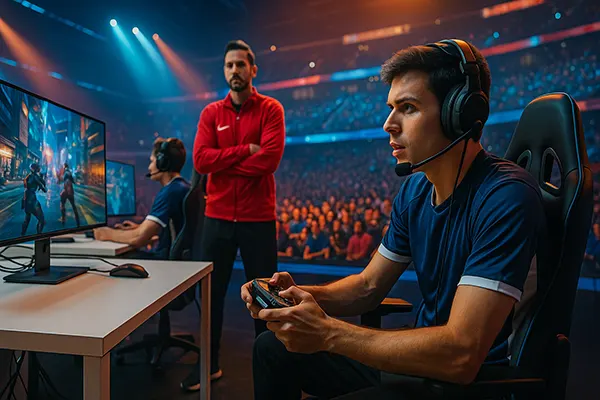
How Sports Brands are Integrating eSports into Their Marketing Strategies: From Traditional to New Formats
In recent years, eSports has rapidly gained popularity, becoming a significant segment of the entertainment and sports industries. As traditional sports brands look to connect with a younger, digitally-savvy audience, many have integrated eSports into their marketing strategies. This article explores how sports brands are making this shift, the new opportunities this presents, and how marketing techniques are evolving in response to the rise of eSports.
Integrating eSports into Traditional Sports Marketing Strategies
Sports brands have long dominated the global marketing landscape, with sponsorships, merchandise, and media rights forming the backbone of their marketing activities. However, the emergence of eSports has prompted many brands to explore new ways to reach their audience. Traditional sports marketing strategies have been adapted to embrace eSports, allowing brands to tap into a growing digital demographic. This integration involves collaborating with eSports teams, hosting online tournaments, and sponsoring events that blend both traditional sports and eSports.
By partnering with established eSports leagues or individual players, brands are able to leverage the popularity of these gaming platforms. The sponsorship of eSports events by big-name brands is not just about exposure but also about aligning with the cutting-edge innovation that eSports represents. These collaborations offer new forms of fan engagement and ways to interact with an audience that is deeply immersed in the digital world.
The digital environment of eSports also offers brands a unique opportunity to engage with younger generations who may not be as interested in traditional sports. By capitalising on the eSports boom, brands can tailor their messages to a more targeted, tech-savvy demographic, using new platforms such as streaming services like Twitch, YouTube, and social media to reach a wider audience.
New Digital Platforms and Their Role in Sports Marketing
Digital platforms play a pivotal role in the integration of eSports into traditional sports marketing. Live streaming platforms such as Twitch have allowed eSports to reach millions of viewers worldwide, providing a unique opportunity for brands to place advertisements or sponsor content. These platforms offer a direct connection to fans, making it easier for brands to create personalised experiences and engage in real-time interactions.
Moreover, social media platforms like Instagram, Twitter, and Facebook are being used to amplify eSports events, promotions, and branded content. By sharing highlights, behind-the-scenes footage, and engaging with fans on social media, sports brands can build a strong connection with their audience, driving engagement and loyalty.
The ability to track audience engagement and measure the success of campaigns on these platforms provides a level of data-driven marketing that was not previously available in traditional sports. This allows brands to refine their strategies in real-time, ensuring they get the most out of their marketing investments.
Brand Engagement Through eSports Sponsorships
Sponsorship in eSports is one of the most common ways for sports brands to engage with the industry. From team sponsorships to event sponsorships, eSports presents a new frontier for brands to explore. Major sports brands are increasingly investing in eSports teams, providing sponsorships and merchandise that resonate with gamers. By associating themselves with popular eSports teams, brands tap into an already established fanbase, leveraging the team’s popularity to elevate their own image.
Additionally, many sports brands are now co-sponsoring eSports tournaments, where they gain direct exposure to a global audience. These sponsorships often include brand activations at live events, digital billboards, and even virtual merchandise. The integration of branded content in gaming streams and video games themselves is another effective strategy for driving brand visibility.
In the context of sponsorship, the partnership goes beyond simple visibility. Sports brands often integrate themselves into the fabric of the gaming experience by creating custom in-game items or challenges. These in-game experiences allow players to directly interact with the brand, deepening their connection with the product.
The Impact of Influencers and Streamers in eSports Marketing
Influencers and streamers have become an integral part of eSports marketing. These individuals, often professional gamers or popular gaming personalities, have millions of followers who look to them for gaming advice, entertainment, and lifestyle inspiration. By partnering with these influencers, sports brands can access a loyal and engaged audience.
Streamers provide a unique platform for live advertising, product placement, and branded content. During their streams, brands can reach viewers who are not only watching the game but are also engaging in the streamer’s commentary and opinions. This allows brands to craft highly targeted, authentic marketing campaigns that feel natural and relevant to the audience.
Additionally, influencer-led marketing campaigns in eSports often allow for interactive engagement, where fans can participate in live Q&A sessions, gaming challenges, or even giveaways sponsored by the brand. This form of marketing builds trust and credibility with the audience, who value the personal connection they share with the influencers they follow.

Exploring New Formats: Virtual Competitions and Cross-Industry Partnerships
The integration of eSports into traditional sports marketing has also spurred the creation of new formats. Virtual competitions, where gamers compete using simulation games based on traditional sports, are an excellent example of this trend. These events allow sports brands to tap into both the eSports and traditional sports audiences simultaneously. Virtual Formula 1, for example, combines real-world motorsport with the digital world, attracting fans of both disciplines.
Cross-industry partnerships are another innovative way that sports brands are expanding their reach. For instance, collaboration between gaming companies and traditional sports teams allows for the creation of exclusive content, merchandise, and competitions. These partnerships blur the lines between the physical and digital worlds, enabling fans to experience a multi-layered form of entertainment.
The convergence of sports and gaming continues to evolve, offering new ways for brands to stay relevant in an increasingly digital-first world. As more traditional sports brands step into the eSports arena, the industry will continue to expand, presenting even more opportunities for creative and innovative marketing strategies.
The Future of Sports and eSports Marketing
The future of sports and eSports marketing lies in further integration and innovation. As technology continues to evolve, so too will the ways in which brands engage with their audiences. Virtual reality (VR) and augmented reality (AR) are expected to play a larger role in the integration of traditional sports and eSports, allowing fans to experience games and tournaments in new and immersive ways.
Furthermore, the rise of blockchain technology and NFTs (non-fungible tokens) is opening new avenues for sports brands to engage with their fans. By offering exclusive digital assets, sports brands can create new revenue streams and deepen fan loyalty in the process.
Ultimately, the integration of eSports into traditional sports marketing strategies is reshaping the landscape of fan engagement. As both industries continue to grow, the potential for new and innovative marketing opportunities remains boundless, and brands that embrace this change will be at the forefront of a new era in sports marketing.
Last posts
-
 Green Marketing in Sports: How Clubs and B...
Green Marketing in Sports: How Clubs and B...
In 2025, sustainability has become an inseparable part …
-
 Ethics, Responsible Play and Marketing in ...
Ethics, Responsible Play and Marketing in ...
The intersection of sports and gambling industries has …
-
 Micro-Influencers in Niche Sports: The Hid...
Micro-Influencers in Niche Sports: The Hid...
In 2025, marketing in the sports industry is …
